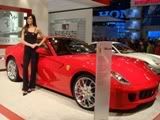
History
Enzo Ferrari was born on February 18, 1898 near Modena, Italy. When he was 10 his father took him to an automobile race in Bologna. After attending a number of other races, he decided he wanted to become a racing car driver.
While working at a small carmaker involved with converting war surplus, Ferrari took up racing. In 1919 he finished ninth at the Targa Florio. He ended up landing a job with Alfa Romeo and drove a modified production car in the 1920 Targa Florio. Ferrario managed to finish second.
In 1923 while racing at the Circuit of Sivocci at Ravenna he was approached by Count Enrico and Countess Paolina Baracca, the parents of the heroic Italian pilot Francesco Baracca. Francesco was known as the Italian ace of aces. He died on Mount Montello during the war. His parents gave Ferrari their son's squadron badge, which was the famous prancing horse on a yellow shield.
Enzo Ferrari was connected with Alfa Romeo for many years, however, he built only a few sports cars bearing his name and his famous prancing horse badge. In 1929 Enzo formed the Scuderia Ferrari with the aim of organizing racing for members. The Scuderia Ferrari team competed in 22 events and scored 8 victories and several good placings.
In 1940 Enzo Ferrari left Alfa Romeo and started a new company Auto-Avio Costruzioni Ferrari. During World War II the Ferrari workshop moved from Modena to Maranello. The workshop became a victim of the war in 1944 - it was leveled by bombs. A year after the war in 1946 the shop was rebuilt and work began on the first ever Ferrari motorcar, the 125 Sport. This car started a grand tradition of winning for Ferrari. Since it's first race in 1947, Ferrari's have had over 5,000 successes on race tracks around the globe.









